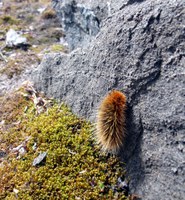Dakota Gardener: How Do Insects Survive Winter?
(Click an image below to view a high-resolution image that can be downloaded)
By Tom Kalb, Horticulturist
NDSU Extension
Insects are the ultimate survivors.
While we shiver outdoors in our heavy winter coats, insects are using amazing strategies to survive. Some are producing “antifreeze” inside their bodies and others are migrating thousands of miles, while others are snuggling together in giant clusters.
One of the toughest insects is the woolly bear caterpillar. It produces “antifreeze” chemicals inside its body that allow it to stay alive even when its body is frozen solid. A woolly bear caterpillar can survive in an ice cube for months. The Arctic woolly bear caterpillar can survive temperatures of 70 degrees below zero.
Other insects understand the best way to survive winter is to escape from it. In late August, monarch butterflies in North Dakota begin a flight to Mexico covering more than 2,500 miles. These delicate butterflies will soar in the sky like hawks, gliding 25 miles or more a day.
What’s really amazing is these monarch butterflies, which were born this year, will fly to the same villages and sometimes even the same trees in Mexico as their ancestors flew to in previous years. That’s what I call a “family tree.”
How does this happen? They are not using any maps or GPS. It must be in their DNA. These exhausted butterflies will find a mate and die in Mexico, but their offspring will fly back north when winter is over.
A flight of 2,500 miles is a long trek to escape winter. The escape routes for other insects are much shorter. For example, immature dragonflies in North Dakota migrate only a few inches, digging in the soil beneath frozen ponds to survive winter. Likewise, grubs in your lawn burrow only several inches down to escape freezing to death.
Many insects in North Dakota survive by working together as a group. For example, honeybees form a ball inside their hive and vibrate their wing muscles to make warmth. This vibration creates temperatures around 90 degrees near the inside of the ball, where the queen stays. The bees take turns being in the warm center and they all share honey to maintain their strength during the winter.
Ladybugs also group together to stay warm. In the fall, they swarm together into clusters to snuggle and conserve heat. One cluster may have thousands of ladybugs. They seek shelter near homes, under rocks and leaves, in tree crevices or other debris and rely on the fats stored in their bodies to survive.
Not all insects can survive winter here in North Dakota. Many of us have heard about emerald ash borer, a pest that has killed millions of ash trees in the U.S. This insect from China produces antifreezing chemicals inside its body that may allow it to survive temperatures of 20 degrees below zero. The pest has become established in Minnesota and South Dakota.
The good news is our winters in North Dakota are colder. I never thought I would be happy about that! Our frigid winter is our best protection against most insects.
Stay warm and happy holidays.
For more information about gardening, contact your local NDSU Extension agent. Find the Extension office for your county at https://www.ag.ndsu.edu/extension/directory/counties.
NDSU Agriculture Communication - Dec. 22, 2020
Source: Tom Kalb, 701-328-9722, tom.kalb@ndsu.edu
Editor: Ellen Crawford, 701-231-5391, ellen.crawford@ndsu.edu




